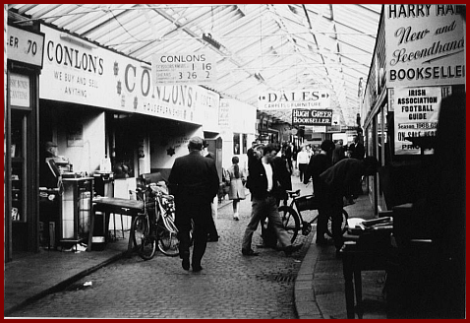
Old Smithfield, from Joe Graham's great site exploring old Belfast
http://smithfieldmarket.rushlightmagazine.com/
Smithfield Market (Ciaran Carson)
Sidelong to the arcade, the glassed-in April cloud – fleeting, pewter-edged -
Gets lost in shadowed aisles and inlets, branching into passages, into cul -de-sacs,
Stalls, compartments, alcoves. Everything unstitched, unravelled – mouldy fabric,
Rusted heaps of nuts and bolts, electrical spare parts: the ammunition dump
In miniature. Maggots seethe between the ribs and corrugations.
Gets lost in shadowed aisles and inlets, branching into passages, into cul -de-sacs,
Stalls, compartments, alcoves. Everything unstitched, unravelled – mouldy fabric,
Rusted heaps of nuts and bolts, electrical spare parts: the ammunition dump
In miniature. Maggots seethe between the ribs and corrugations.
Since everything went up in smoke, no entrances, no exits.
But as the charred beams hissed and flickered, I glimpsed a map of Belfast
In the ruins: obliterated streets, the faint impression of a key
Something many-toothed, elaborate, stirred briefly in the labyrinth.
But as the charred beams hissed and flickered, I glimpsed a map of Belfast
In the ruins: obliterated streets, the faint impression of a key
Something many-toothed, elaborate, stirred briefly in the labyrinth.








































